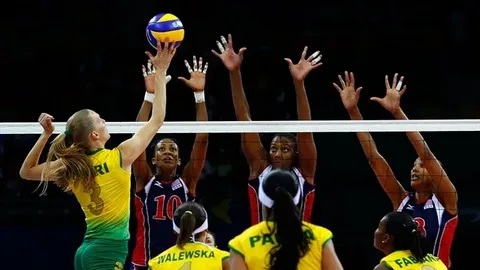How Many Players Play in Volleyball? A Complete Guide to Volleyball Team Sizes, Roles, and Variations
Introduction to Volleyball
Volleyball is one of the most popular sports worldwide, played in both indoor and beach settings. Whether it’s the thrill of diving for a spike or coordinating with teammates, volleyball offers an exciting combination of athleticism, strategy, and teamwork. While indoor volleyball and beach volleyball share many similarities, they differ in terms of team size, rules, and the overall game experience.
In this article, we’ll answer the frequently asked question: How many players play in volleyball? You’ll learn about the standard team sizes for indoor and beach volleyball, each player’s role, and why team size matters. Let’s jump in!
How Many Players Play in Volleyball?
When people ask, “How many players play in volleyball?” the answer depends on the type of volleyball being played. Indoor volleyball generally requires six players on each team, while beach volleyball is played with just two players per side. These variations reflect different game strategies and the physical demands of each type.
Indoor Volleyball Team Size
In indoor volleyball, teams are composed of six players on the court at a time. Each player has a unique role, whether it’s setting, hitting, blocking, or defending, which makes the game both dynamic and challenging.
Roles of Indoor Volleyball Players
Each player on an indoor volleyball team has specific responsibilities. Here’s a quick look at the main positions:
Setter: The strategist who sets up plays, usually making the second touch on the ball.
Libero: A specialized defensive player focused on receiving serves and digs.
Outside Hitter: Known for powerful attacks, often plays on the front left.
Opposite Hitter: Positioned opposite the setter, contributes both offensively and defensively.
Middle Blocker: Specializes in blocking and quick attacks.
Together, these players create a balanced team focused on both offense and defense.
Beach Volleyball Team Size
Beach volleyball is played with only two players on each team. Without any substitutions, both players must be versatile, covering attacks, blocks, and defense. Each player is expected to handle various responsibilities, and the smaller team size often requires strong endurance and adaptability.
Why Are There Fewer Players in Beach Volleyball?
Beach volleyball’s two-player format is a natural fit for the sport’s environment. With a smaller court and sand adding resistance, players cover less ground and adapt their strategies. The open environment also allows for a faster-paced game that requires quick thinking and a strong connection between teammates.
Other Variations in Volleyball
Other forms of volleyball, like three-player and four-player versions, are popular in recreational settings. These variations allow for more people to participate and usually have more relaxed rules.
How Substitutions Work in Volleyball
Substitutions in indoor volleyball allow teams to switch players based on strategy or fatigue, with specific rules governing the number and timing of substitutions. In contrast, beach volleyball does not allow substitutions, which requires the two players to handle the entire game themselves.
Volleyball Positions and Their Responsibilities
Volleyball players must communicate and coordinate to keep their positions and strategies on point. Here’s how each role fits into the team’s gameplay:
Setters initiate offensive plays and adapt their tactics based on the game.
Liberos bring defensive stability, especially in serve-receive situations.
Hitters and Blockers focus on scoring points through aggressive play at the net.
Each position requires specific skills, and mastering these skills allows teams to execute complex plays.
Special Roles: The Libero in Indoor Volleyball
The Libero plays a unique role in indoor volleyball, dedicated to defense and allowed to substitute freely without using a substitution slot. Their specialized skills in receiving and digging make them crucial for defending against powerful attacks.
How Volleyball Team Size Impacts the Game
Team size influences the style of play in volleyball. Indoor volleyball focuses on coordination and planned strategies, with players executing roles that contribute to an overarching team strategy. Beach volleyball, on the other hand, emphasizes adaptability and endurance due to its smaller team format.
How to Form a Volleyball Team
When building a volleyball team, it’s important to consider each player’s strengths and skills. Assign roles based on ability and create practice routines that enhance teamwork and communication. A well-rounded team will be better prepared to face opponents.
Common Questions About Volleyball Team Sizes
How many players play in volleyball internationally?
Internationally, standard team sizes follow the six-player indoor format and two-player beach format.
Can volleyball be played with more or fewer players?
Absolutely! Recreational games often adapt team sizes based on the number of players available.
FAQs
Can volleyball teams have more than six players?
Yes, some variations allow for more players, especially in casual or recreational games.
Why does beach volleyball only have two players?
The smaller team size suits the physical demands of sand and allows for a faster-paced game.
What role does the Libero play?
The Libero specializes in defense and is allowed free substitutions to enhance team stability.
How many players are on a volleyball team including substitutes?
In indoor volleyball, a team typically includes six starting players and can have up to six substitutes.
Is volleyball played with different team sizes around the world?
The standard team sizes are widely recognized, but different variations exist, especially in informal games.
Conclusion
In conclusion, when answering How many players play in volleyball? it depends on the format. Indoor volleyball involves six players per side, each with a unique role, while beach volleyball is played with two players who must be versatile and adaptable. Both formats offer unique challenges and experiences, making volleyball a diverse and thrilling sport. Whether you’re looking to join a team or watch a game, understanding the team dynamics can make your experience even better.

